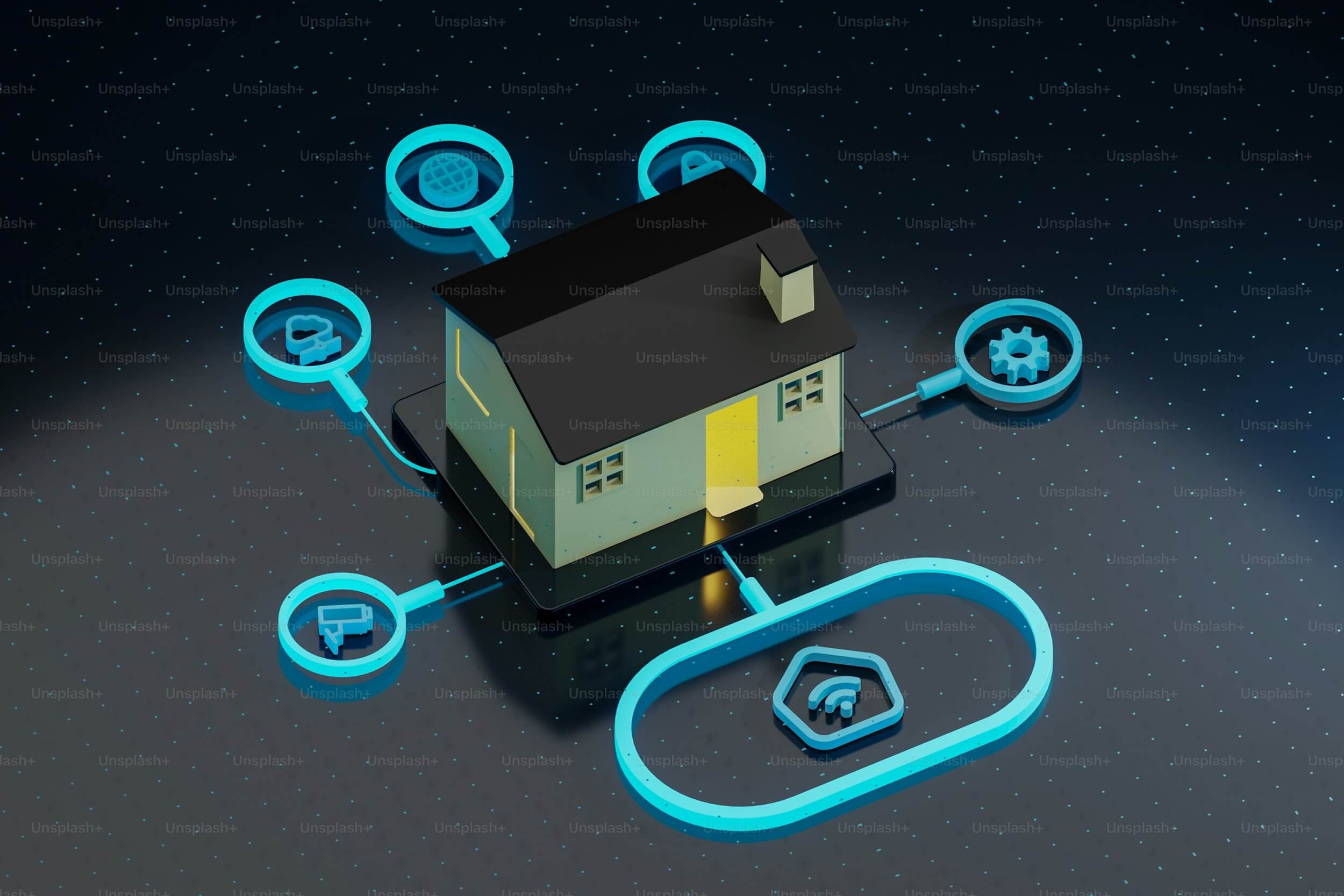
The first Bitcoin block was produced on 3 January 2009, thus starting the blockchain network. Fifteen years later, this network unites thousands of individual and enterprise miners who hunger to release a new Bitcoin and earn rewards in return. However, it is believed that mining crypto coins such as free ethereum is too complicated for beginners and non-techies.
Home mining: https://unsplash.com/photos/a-house-connected-to-a-network-with-blue-lights-zZrtuNA9TYU
Have things changed in 2024? Is there an energy-effective way to mine BTC, ETH, and altcoins? How to mine Bitcoin at home? Learn all the answers and step-by-step instructions from this Bitcoin mining guide 2024.
How to Set Up Home Mining?
Among passive crypto income methods, BTC mining is a standalone one. Its setup and operation require specific hardware and software. You’ll have to choose a mining pool and make accurate calculations to ensure the power efficiency of your network. Let’s have a detailed look at these undertakings.
Step 1: Evaluate Your Setup Requirements
Home-based Bitcoin mining will only be profitable if you establish it on solid hardware. You should also consider that the thing consumes significant amounts of electricity and requires a physical medium with enough space.
Hardware Considerations
Today, BTC mining is a tough competition with thousands of well-equipped miners engaged. It doesn’t mean you cannot win your place in this competition, but you’ll need proper equipment to make an adequate start. An essential component for your DIY Bitcoin mining setup is an ASIC chip. This technology was invented in 2013 and revolutionized the entire BTC mining industry. Its benefits over outdated CPU-, GPU-, and FPGA-based equipment are as follows:
● Initially designed for crypto mining.
● Provide better output.
● More efficient from a hash rate power perspective.
● More affordable for crypto mining from home.
ASIC, or so-called Antminer hardware, is the most effective strategy in today’s competition. Like any other method, it requires initial investments, but it is crucial for ensuring power efficiency and the overall success of your network.
Litecoin & Hardware Chip: https://unsplash.com/photos/a-close-up-of-a-computer-chip-with-the-letter-l-on-it-E6NWkgDuj5w
Electricity & Space
The next point to consider is the cost of electricity your mine will consume. Your expenses will depend on the electric power rates fixed in your location. Mining Bitcoin with ASIC is the most advanced approach. In 2024, a number of next-generation Antminer solutions came to the market.
However, be ready to provide enough space for your equipment. It is also crucial to ensure proper cooling for your system. In ultra-modern hardware, temperatures may go up to 45 degrees Celsius, so you’ll need to install additional coolers, air ventilation systems, and other equipment to raise the efficiency of your home-based mine. All this is sure to occupy a specific space, which you should consider beforehand.
Step 2: Choose Your Mining Software
In 2024, you can pick an Antminer with built-in crypto mine software. However, you may wish to install specific software manually. Then, the chosen app should comply with your hardware type (ASIC, GPU, etc.) The top popular software solutions in today’s industry include GGMiner, ASICSeer, BFGMiner, and Easy Miner.
Choosing the right software may be a daunting undertaking. You need to know what type of crypto mine you wish to establish and the expected size of Bitcoin mining profitability. Things to consider in the first place are listed below:
1. Smooth compliance with your hardware.
2. Software algorithms that match your chosen crypto coin (BTC, ETH, or another.)
3. Built-in features for managing power efficiency.
4. Scalability for those who plan to upgrade.
5. Strong protective measures for your network security.
Decentralization, blockchain: https://unsplash.com/photos/a-computer-generated-image-of-a-network-of-spheres-LUExqP65ifM
Other factors important for your choice include automatic updates and vulnerability checks. We recommend shopping around and comparing various solutions available on the market before opting for any. You can build the very mining software you need with your own hands, too! However, this requires you to be an experienced developer with proper knowledge of crypto algorithms.
BTC Mining Software Setup
As soon as you are ready with your choice, you need to complete the Bitcoin mining software setup. It is simple to do. What is also important is that most software can be downloaded and installed for free. You’ll need to take these steps:
1. Download the targeted software onto your computer.
2. Explore the chosen app’s documentation.
3. According to the instructions provided by the developer, configure the software so that it suits your needs.
4. Check how the installed components co-operate with your hardware.
5. If you experience compatibility issues, re-install the software or contact support for troubleshooting.
That’s it. Now, your software and hardware are ready to solve math problems and coin new blocks to the blockchain.
Step 3: Joining a Mining Pool or Opting for Mine Solo?
In fact, you have everything you need to start crypto mining from home now. However, one more effective move you may take is joining a powerful mining pool. Mining pools represent miner communities or sorts of artels. They allow users to cooperate and raise the computer efficiency of their networks.
Ethereum blockchain: https://unsplash.com/photos/a-black-and-white-photo-of-cubes-on-a-black-background-IlUq1ruyv0Q
There are various pools, but their idea is the same. You join the mining group and contribute to coining new blocks. Then, you earn your rewards according to the size of your contribution. Such a scheme is especially reasonable for home miners, as it allows them to ensure quick and frequent rewards. The list of reliable pools with affordable fees includes Slush Pool, AntPool, and F2Pool.
If you opt for solo mining, be ready for heavy investments at the initial stage. It may take time to earn your first income this way. However, the future rewards will be much higher in the long run, especially if you’re going to employ optimized Bitcoin mining hardware produced in 2024.
Step 4: Configure and Start Mining
Now, it’s time to configure your hardware and software to ensure the seamless work of both components. Before you start mining, you need to take these steps:
1. Provide your software with your URL or the URL of the chosen mining pool.
2. Indicate your miner name and password.
3. Insert your crypto wallet address to store the rewards there. Set up one if you haven’t ityet.
4. Install all the necessary apps to monitor the performance of your network.
Tracking your network’s statistics and progress is crucial for the efficient work of the entire system. You can use the data provided by your software’s dashboard, or you can apply specialized software. For instance, you can set up NiceHash or MinerStat to get access to detailed reports on your BTC mine’s profitability.
Bitcoin Gold Image: https://unsplash.com/photos/a-gold-bit-coin-sitting-on-top-of-a-black-table-k9IbEseIQ04
Step 5: Calculate Profitability
Measuring costs and expected profits is fundamental for your project. The key factors to include in your calculations are as follows:
● The local electricity rate.
● Hash rate & network difficulty.
● Mining pool fees.
● Price volatility of the chosen crypto coin.
Calculating your profit is a simple thing. You can use the formula below:
If you do not wish to beat your brains by making complex calculations, you can use ready calculators online. The available Bitcoin mining hardware 2024, together with profitable electricity rates, can lead you to a truly cost-efficient home crypto mine.
Tips for Optimizing Home-Based Mining
The key point for any crypto miner is to raise the efficiency of their network. Besides implementing energy-effective Bitcoin mining hardware, they can also optimize their home-based mine by taking these actions:
1. Opt for renewable energy supplies (solar panels, wind energy, etc.)
2. Increase mining activities at off-peak periods.
3. Protect your hardware against overheating by using quality coolers, cleaners, etc.
4. Communicate with other miners to share experiences, adopt useful innovations, and troubleshoot.
These rules will help maximize your return. We also recommend following the crypto miner communities and top influencers to stay updated on the news.
Conclusion
Thanks to advanced technology and highly efficient equipment, home-based Bitcoin mining can be a profitable undertaking in 2024. However, certain preparations and thorough profit calculations are needed to run a successful crypto mine.
Unlike other passive crypto income methods, mining requires purchasing hardware, installing specific applications, and providing enough room for your mine. You should also consider your local electricity rate, which will be a decisive factor for your Bitcoin mining profitability. Only after you totalize all these factors can you switch to setting up your mining project. Today, this process is a breeze.
Disclaimer: This article is for informational purposes only and does not constitute financial advice. Cryptocurrency investments carry inherent risks; always conduct your own research before making investment decisions.










